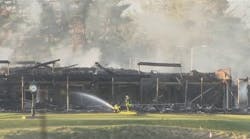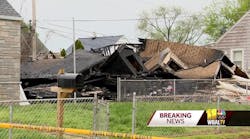Last month, we discussed the tragic double firefighter line-of-duty deaths that occurred in Colerain Township, OH, on April 4, 2008. Colerain Township Captain Robin Broxterman, 37, and Firefighter Brian Schira, 29, died in the line of duty after the floor they were on collapsed at a fire in a single-family dwelling. Following that tragic loss, the department issued a preliminary report with initial details on what happened based on the information available at the time. A more in-depth final report is being developed and is expected to be released in 2009, along with a report by the National Institute for Occupational Safety and Health (NIOSH).
The intent of this account is to show how one fire department applied the initial lessons learned from another department — and how it mattered. Each month, the Close Calls column in Firehouse® Magazine is about learning from serious events that could have been worse. On occasion, we cover a line-of-duty death to learn from it. What is absolutely critical for readers to understand is that this, as in many close calls and line-of-duty deaths, was a typical single-family-dwelling fire that resulted in horrific losses — losses that we have an opportunity to learn from.
Of the many lessons learned at the Colerain fire, one that must be reiterated is that firefighters responding specifically to single-family-dwelling fires must perform a 360 as a part of their size-up prior to being able to make strategic and tactical decisions. If a 360 is not initially conducted, it is impossible to properly define the fire problem, perform a size-up and afford the best chance for firefighters to survive when operating interior. Officers sizing-up the incident must acknowledge that "this incident could go to hell at anytime, so what does that mean to my crew and what can we do to minimize that potential?"
Our thanks to the officers and members of the Colerain Township Department of Fire and EMS and the Defiance Fire and Rescue Division for their assistance with this two-part column. My special thanks to Colerain Chief Bruce Smith and his staff and Defiance Chief Mark Marentette and his staff for providing their passionate insight and sincere desire to share all the facts of both of these fires. We further dedicate both parts of this column to Captain Broxterman and Firefighter Schira as their tragic loss has not been in vain.
This account was prepared by Chief Mark Marentette of the Defiance Fire and Rescue Division:
Three minutes and 34 seconds…On Feb. 8, 2009, had it not been for a change in how the Defiance Fire and Rescue Division conducts 360-degree size-ups, three minutes and 34 seconds would have been just enough time for two firefighters to quite possibly lose their lives in a house fire. The change had been debated among Defiance Fire and Rescue's rank and file for months until July 2008, when the Colerain Township Department of Fire and EMS issued its preliminary report on the April 4, 2008, line-of-duty deaths of Captain Robin Broxterman and Firefighter Brian Schira.
For Defiance Fire and Rescue, the Colerain Township report settled the debate. We discontinued our practice of always having the 360-degree size-up performed by a chief officer, who often is not on scene until several minutes after first-in firefighters have already initiated interior operations. Instead, the 360-degree size-up is now conducted by the officer on the first-arriving apparatus or a simultaneously arriving chief officer before any firefighters make entry into the structure.
Because of the change, the initial view of the house from the street on Feb. 8 — heavy smoke, no visible fire — did not fool Lieutenant Steve Johnson and Firefighter Tim Moog into entering through the front door and groping their way through the smoke across a lightweight floor on the verge of total collapse. The floor collapsed into a walkout basement fully involved in fire within the next three minutes and 34 seconds — the time that lapsed between the arrival of Lieutenant Johnson, Firefighter Moog and two other firefighters, and the arrival of Assistant Chief Pete Schlosser. Had Defiance Fire and Rescue operated under its previous fireground procedures, the 360-degree size-up would not have occurred until Chief Schlosser arrived. By then, Lieutenant Johnson and Firefighter Moog could already have plunged through the weakened floor into the fire below.
The first alarm for the fire sounded at two minutes and 46 seconds past midnight as dispatchers received several reports of heavy smoke rolling across the street. At the time, the on-duty shift had been depleted by a response to an EMS call that had come in 18 minutes earlier. Lieutenant Johnson and Firefighters Moog, Chad Brown and Joe Koelsch responded to the fire from Defiance's Central Fire Station. Simultaneously, automatic call-in of all available off-duty full-time and auxiliary personnel was initiated and the Noble Township Fire Department was dispatched on automatic aid.
"Had I not done a 360, I believe we would have made entry at the front door of the structure and the conditions we encountered would have been dire," said Lieutenant Johnson, who has nearly 12 years of experience. "With the initial response of four personnel, no one would have been available for any rescue operations, had they even noticed there was a problem in a timely manner. At this time, Firefighter Brown was running the engine and Firefighter Koelsch was finishing the hydrant connection."
Lieutenant Johnson's company arrived four minutes and 12 seconds after the first alarm. A review of radio traffic indicates that Lieutenant Johnson and Firefighter Moog would have been masked up and through the front door with a charged 1¾-inch pre-connect within the next 1½ minutes had Lieutenant Johnson not conducted the 360. The pair would have been inside for roughly a minute before Firefighter Koelsch opened the hydrant and made his way to the front door to feed hose, two minutes before Chief Schlosser arrived on scene and 6½ minutes before call-back personnel began to arrive with additional apparatus.
"On arrival, I observed heavy smoke conditions and fire from the rear of the structure," said Chief Schlosser. "The first-in engine had dropped a line from the hydrant, which was charged, and lines were stretched to the front and side of the structure."
Chief Schlosser's observations reflect the traditional aggressiveness — and speed — of Defiance firefighters. First-due Defiance firefighters do not waste any time in making entry into burning buildings unless conditions are obviously too dangerous. They know that the remainder of the initial alarm assignment, on average, lags eight minutes behind arrival of the first-in company. They know their best chance to safely stop a working fire is with a quick hit. On average, Defiance firefighters save three out of every four occupied structures involved in fire in the city — yet, they have not suffered a single serious fireground injury in more than 25 years.
Hence, it was difficult for Defiance firefighters to even consider slowing down on arrival at a structure fire for a 360-degree size-up that had been the responsibility of the first-arriving chief officer. However, through training brought on in part by Colerain Township's loss, Defiance firefighters have developed procedures to still rapidly deploy on the fireground with the intent of making an aggressive interior attack — at the same time the first-arriving officer performs the 360. The procedures do not slow firefighters in getting a charged line to the door; but the 360 protects them from going through the door into a situation from which they could not return.
"As we approached the residence, the smoke was very dense, obscuring a good view of the scene," said Lieutenant Johnson. ". As Firefighter Moog packed up, I advised him that I was going to do a 360 of the house. I placed a set of irons in the area of the front door, where I had assumed we would make entry. I started walking around toward the D side. As I approached the D-C corner of the structure, I found heavy flames coming from all levels — basement, main level and roof area — of the C side. Flames were bluish in color, leading me to believe we may have had a gas line leak. As I continued around the house, I found the gas shutoff on the A side, but was unable to turn it off. At this time, Firefighter Moog was waiting for me with a line stretched to the front door. I advised Firefighter Moog of the conditions I had encountered, and advised we would be making a defensive attack at the rear of the structure."
Photos taken by a Defiance police officer and Chief Schlosser early in the incident confirm that the view from the street was of what appeared to be a 1½-story structure with no visible fire. From Side C, however, the simultaneous view was of the walkout basement fully involved with extension to the main floor and above.
"While pulling up to the scene, I thought to myself, where is the fire producing all the smoke?" said Firefighter Moog, a 16-year veteran who was due to be promoted to lieutenant in April. "I was unable to see any type of glow or flames. I grabbed the crosslay and stretched it to the front door. At the door, I finished placing on my mask. I was waiting for Lieutenant Johnson or Firefighter Koelsch to go through the front door to make an attack on the fire. Lieutenant Johnson met me at the front door after doing his 360-degree around the house. He stated that we were not going to go through the front door due to the fact that the fire was coming out the walkout basement and the main floor in the back."
Lieutenant Johnson and Firefighters Moog and Koelsch pulled the initial line and a second pre-connect to the rear of the structure. As Lieutenant Johnson directed a stream into the main floor through a patio door he had forced open, Firefighters Moog and Koelsch directed a stream into the walkout basement.
"Approximately 10 to 15 seconds after reaching the (basement) doors, the main floor collapsed into the basement blocking the doors," said Firefighter Moog. "I met up with Assistant Chief Schlosser and informed him that the floor had collapsed."
Ultimately, three 2½-inch handlines and an aerial master stream were placed in operation along with the initial two 1¾-inch pre-connects. Crews did not make headway on the fire until the gas shutoff was closed after great difficulty.
In addition to automatic aid from Noble Township, mutual aid was received from the South Richland Fire Department, the Highland Township Fire Department and the Delaware Township fire department. The cause of the fire remains undetermined.
Final comments by Chief Goldfeder based on facts and discussions with those involved at both fires:
One of my favorite terms is a simple and old one: "Ya neva know." Clearly, in our business, we often do not know what we may encounter, no matter what the caller and dispatchers tell us. There are many situations that we as firefighters respond to that are not always predictable, so we have to constantly train on what may happen or could happen — and expect it. For example, when arriving on the scene of a fire involving a big-box warehouse, a factory or a high-rise building, size-up is not simple; rather, it is complex and requires significant time and resources. However, in most cases, when responding to and arriving at the single-family-dwelling fire, there are few complications related to our immediate ability to do a complete size-up, which should include a 360-degree walk-around to provide us with an accurate and clear picture of what we are dealing with.
Taking time understand what happened at another department's fire is one of the best ways to not repeat history. Be it the close calls we provide monthly in this column, line-of-duty-death reports from individual fire departments such as Colerain or the NIOSH Fire Fighter Fatality Investigation and Prevention reports (that are more in-depth than ever), we have excellent opportunities to learn without repeating tragic results. (NIOSH reports are available at http://www.cdc.gov/niosh/fire.)
While "ya neva know" is applicable in some cases, conducting that full size-up on a single-family dwelling, including a 360, will provide you and your firefighters with that much more information that allows you "to know" just that much more. As firefighters, every bit of information in helping us best understand what we are dealing with is essential to our success. Take time to best understand what you are getting into, and what the conditions are before going in — and one of the best ways to do that is with a 360. There is rarely a need to operate "one dimensional."
WILLIAM GOLDFEDER, EFO, a Firehouse® contributing editor, is a 33-year veteran of the fire service. He is a deputy chief with the Loveland-Symmes Fire Department in Ohio, an ISO Class 2 and CAAS-accredited department. Goldfeder has been a chief officer since 1982, has served on numerous IAFC and NFPA committees, and is a past commissioner with the Commission on Fire Accreditation International. He is a graduate of the Executive Fire Officer Program at the National Fire Academy and is an active writer, speaker and instructor on fire service operational issues. Goldfeder and Gordon Graham host the free and noncommercial firefighter safety and survival website www.FirefighterCloseCalls.com. Goldfeder may be contacted at [email protected].





